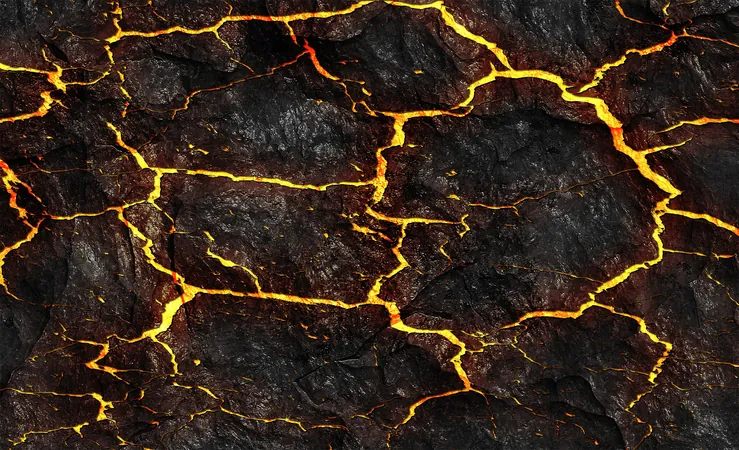
Earth's Hidden Gold Rush: How Precious Metals Are Seeping Up from the Core
2025-05-28
Author: Wei
A Wealth of Metal Beneath Our Feet
Deep within Earth’s crust lies an astonishing treasure of precious metals, including gold and ruthenium. For years, scientists assumed these valuable resources were trapped near the planet's core-mantle boundary, a staggering 1,900 miles underground. But groundbreaking new research is flipping this assumption on its head!
Volcanic Eruptions Reveal Hidden Secrets
Recent findings reveal that some of these treasures are actually making their way to the surface through volcanic eruptions, particularly on islands like Hawaii. Investigations have detected traces of ruthenium in volcanic lava, indicating a slow but steady leak from Earth’s deepest layers.
Striking Gold: A Revolutionary Discovery
Dr. Nils Messling from the University of Göttingen exclaimed, "We literally struck gold! Our data confirmed that core-derived materials, including gold and other precious metals, are seeping into the Earth’s mantle above." This groundbreaking discovery highlights the movement of metals from the core to the surface, challenging previous assumptions about Earth's structure.
The Role of Mantle Melts
Professor Matthias Willbold, also from the University of Göttingen, added, "Our findings suggest that gigantic volumes of super-heated mantle material, totaling hundreds of quadrillion metric tons of rock, originate at the core-mantle boundary and ascend to form volcanic islands like Hawaii." The volcanic activity in these regions offers a unique glimpse into how metals could ride streams of molten rock to reach shallower depths. This slow trickle over millions of years could accumulate substantial amounts of valuable elements.
Unlocking the Mystery of Rare Metal Deposits
This new understanding could explain the presence of gold and similar metals used in modern technologies — metals that perhaps once resided near Earth’s core. Since precious metals are integral in sectors like renewable energy, electronics, and medicine, the implications are vast. Current studies are still uncovering just how significant this upward flow of metals is, prompting new inquiries regarding the formation of mineral deposits.
Shifting Perspectives on Earth's Inner Workings
Long thought to be an isolated reservoir, Earth’s core now appears to engage in a slow but crucial exchange of materials with the mantle. As researchers explore whether these metal movements have persisted since Earth’s formation, they reveal that even a minimal flow of metal can significantly affect geochemistry.
Age-Old Origins: Metals from Earth's Early Days
The movement of ruthenium isotopes suggests that some of the core's materials might date back to Earth’s earliest days. This hints at a chemical fingerprint of ancient planetary building blocks, offering rare insights into events that occurred over 4.5 billion years ago.
Implications for Future Research and Resource Management
These discoveries extend beyond geological curiosity. The presence of metals from the core near Earth’s surface could reshape models of heat flow, magnetic field generation, and deep mantle convection. Furthermore, it may eventually transform how we locate and evaluate mineral resources, especially in previously overlooked volcanic areas.
The Path Ahead
Moving forward, researchers are set to pinpoint the rate at which these metals flow from the core and ascend through the mantle. By analyzing isotope measurements of additional elements, scientists aim to answer profound questions regarding Earth’s formation, the ongoing interactions within its layers, and the origins of the metals essential to modern technology.
This remarkable study not only challenges traditional views but also illuminates new dimensions of Earth's complexity. The findings are published in the renowned journal Nature.




 Brasil (PT)
Brasil (PT)
 Canada (EN)
Canada (EN)
 Chile (ES)
Chile (ES)
 Česko (CS)
Česko (CS)
 대한민국 (KO)
대한민국 (KO)
 España (ES)
España (ES)
 France (FR)
France (FR)
 Hong Kong (EN)
Hong Kong (EN)
 Italia (IT)
Italia (IT)
 日本 (JA)
日本 (JA)
 Magyarország (HU)
Magyarország (HU)
 Norge (NO)
Norge (NO)
 Polska (PL)
Polska (PL)
 Schweiz (DE)
Schweiz (DE)
 Singapore (EN)
Singapore (EN)
 Sverige (SV)
Sverige (SV)
 Suomi (FI)
Suomi (FI)
 Türkiye (TR)
Türkiye (TR)
 الإمارات العربية المتحدة (AR)
الإمارات العربية المتحدة (AR)